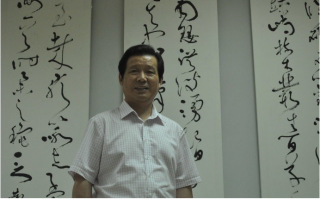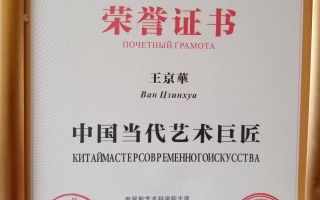《到中国美术馆参观百年知白画展》
- 2021-04-15 10:40:15
- 点赞量:8320
- 点击量:131192
- 作者:郝连成 Hao Liancheng

10月30日,郝连利与其兄来到中国美术馆,参观了刘知白先生的画展。
On October 30, Hao LIANLI and his brother came to the China Art Museum to visit Mr. Liu Zhibai's painting exhibition.
刘知白(1915年--2003年) 号白云,晚号如莲等,安徽凤阳人。1933年考 入苏州美专,后拜顾颜平为师,随师潜心临墓顾氏过云楼藏画。1948年在广 西全州提出“学时有他无我,画时有我无他”的画学主张。其艺术上承宋元,下接明清,既继承传统精髓,又注重形式的创新,最终法古变今,创造了泼墨大写意山水画的新技法,成为中国画传统的最后守望者和世纪创新的前行者。即他已站在了传统与现代的临界点上,预示了新世纪中国水墨转向抽象与表现的历史趋势。出版有《中国近代名家画集刘知白》《刘知白中国画集》 及《清气和诗醉墨痕》《知白守黑》《秋水长天月下潇刘知白作品选》。
Liu Zhibai (1915-2003) was born in Fengyang, Anhui Province. In 1933, he was admitted to Suzhou Art College. Later, he worshipped Gu Yanping as his teacher and went to the tomb with his teacher. Gu's paintings were collected in guoyunlou. In 1948, in Quanzhou, Guangxi, he put forward the idea of "learning without me, painting with me without him". Its art inherited the song and Yuan Dynasties, followed by the Ming and Qing Dynasties. It not only inherited the essence of tradition, but also paid attention to the innovation of form. Finally, it changed from the ancient to the modern, created a new technique of ink splashing freehand landscape painting, and became the last watcher of traditional Chinese painting and the forerunner of century innovation. That is to say, he has stood on the critical point between tradition and modernity, which indicates the historical trend of Chinese ink painting turning to abstraction and expression in the new century. He has published Liu Zhibai, Liu Zhibai's Chinese paintings, Qingqi and traces of drunken poetry, Zhibai shouhei and selected works of Liu Zhibai.

刘知白就在上边的9平方米大的模拟房间做画21年看刘知白的作品,大胆泼辣,率意随心,他的大泼墨画不作画稿,丘墊随呼随出,笔墨随出随变,形导笔随,笔走形化。心随墨运,墨落神生。作品看似混沌一片,但细品微观确有丘壑胎形暗藏其中。体现出了老子的“惚兮恍兮,其中有象。
Liu Zhibai painted in the 9-square-meter simulation room above. After 21 years of watching Liu Zhibai's works, he was bold and shrewd. His big ink splashing paintings didn't make drafts. The mound mat came out as soon as he called, the brush and ink came out as soon as he changed, the shape guide pen came out as soon as he went out, and the pen went out of shape. The heart moves with the ink, and the ink comes to life. The work seems to be in chaos, but the details are hidden in it. It reflects Lao Tzu's "trance", in which there are images.
最让郝连利受益的是刘知白晚年提出的学艺四法即《论“法、守、功、化”》。连利说,若是早些年得到刘知白先生的如此理念,必能少走不少弯路,节省许多时光。郝连利学练书法已近四十多年。虽然在参加一些赛事上也得过奖,被《中国书画报》和中国环球文化艺术网,搜狐网、新浪网,中国书画家影像网、中艺书画网、北京尚远文化传媒网、今日头条等多家文化艺术网以《书法家郝连利华夏之星正在升起》为题进行了宣传。但他自我感觉还是中国文化底蕴尚浅,越往深钻研越有- -种小马拉大车的力不从心的感觉。究其根本原因,还是国学基础不牢。中国的文化上下五千年,儒、释、道、法、兵等思想百家争鸣。历代政治家,艺术家,文人骚客数不胜数,能诗文善书画者,车载斗量。在如此浩繁烟海的华夏文化海洋中能独树一-帜,万绿丛中一点红,非但须要多年的不懈努力,更须要有先贤的指导和帮助,而先贤们的帮助那就是规矩和章法。
What benefited Hao LIANLI most was Liu Zhibai's four methods of learning Arts in his later years, that is, on "law, defense, merit and transformation". If Mr. Liu Zhibai had taken a detour earlier, he would have saved so much time. Hao LIANLI has been practicing calligraphy for more than 40 years. Although he also won awards in some competitions, he was promoted by many cultural and art networks, such as China Pictorial, China Global Culture and art network, sohu.com, sina.com, Chinese Calligraphers and painters image network, Zhongyi calligraphers and painters network, Beijing Shangyuan cultural media network, and today's headlines, with the title of "calligrapher Hao LIANLI, the star of China is rising". But he felt that Chinese culture was still shallow, and the deeper he studied, the more he felt that he was unable to pull a cart. The fundamental reason is that the foundation of Sinology is not solid. Five thousand years of Chinese culture, Confucianism, Buddhism, Taoism, law, military and other ideas contend. There are so many politicians, artists, literati and poets in the past dynasties, who are good at poetry, calligraphy and painting. In such a vast sea of Chinese culture, it takes many years of unremitting efforts to stand alone and get a little red in the green. What's more, it needs the guidance and help of the sages. The help of the sages is the rules and rules.

看刘知白作品展,郝连利最大收获是两条:第一,学时有他无我, 画时有我无他。这是说在初学阶段一写要按老师讲的方法去做,不能参夹自己的“随意性”。在创作时一定不受任何条框限制,完全地表现自我的情感和心怀。第二,就是《法、守、功、化》四字方法。连利说,上北京学习精髓长见识,啥是精髓看这些大师们的作品就是精髓,他们总结出来的学习方法就是见识。回来后还专门让我把刘知白的《论法、守、功、化》的原文找了出来。录到下边,以备随时查阅:
In the exhibition of Liu Zhibai's works, Hao LIANLI's biggest gains are two: first, when he was a student, he had no me; when he was painting, he had me but no him. This means that at the beginning of learning, you should write according to the teacher's method, and you can't participate in your own "randomness". In the creation must not be subject to any restrictions, completely express their own feelings and feelings. The second is the four word method of FA, Shou, Gong and Hua. Lian Li said that learning the essence in Beijing is a long experience. The works of these masters are the essence. The learning method they summed up is the experience. When I came back, I specially asked me to find out the original text of Liu Zhibai's on law, defense, merit and transformation. Record below for reference at any time:

论法守功化一刘知白
On the transformation of law and virtue
我国绘画,由来已久,仅就唐宋而言,代有名流,画家辈出。其中有继承先法者,有自开门径者,承先启后,各有千秋,光耀古今中外,为世人师法而称颂之。我个人从事山水画,对习画历程总结称为“法、守、攻、化”四字,以供启蒙之用。一管之见,未敢言所知之深也,兹分述于次。
China's painting has a long history, only in the Tang and Song Dynasties, there are celebrities and painters. Among them, there are those who inherit the former law, and those who open their own way. They carry on the past and enlighten the future, each with its own merits. They shine at all times and all over the world, and are praised by the world for learning from the law. I am personally engaged in landscape painting, and my learning process is summarized as "Fa, Shou, Gong, Hua" for enlightenment. I'm afraid I don't know the depth of my opinion. I'm going to tell you about it.
一、法字解凡习画者,必须知有法,法者,即方法也。我等在习画始,若不知前人之法,则必是东涂西抹,勉加成图,就有志趣者而言之,也只能落得个涂鸦之叹,其所作之画即很难得推。学书、学画、学文皆不得不首知讲求法则。吾之所言画法, 非只言某家画法为学之者所可遵,某家画法为不可遵。要知中国绘画有其各家之法,即西洋绘画亦各有其历时不同之画法也。
1、 To understand the word "Fa", anyone who practices painting must know that there is a "Fa", and "Fa" means "method". When we began to learn painting, if we didn't know the method of our predecessors, we would have painted everything and tried to make pictures. As far as people with interest are concerned, they can only get a sigh of graffiti, and their paintings are very difficult to push. To learn books, paintings and articles, we have to first know the rules. What I said about painting is not only that a certain painting can be followed by scholars, but also that a certain painting cannot be followed. We should know that Chinese painting has its own methods, that is, Western painting also has its own diachronic painting methods.
要使习画者能得前人某家之法,必须先下基本功夫,掌握有一定之画法与画理,以兹奠定其基础而后力求能发挥自家心得,以至深造而免误入歧途。
In order to make the painters acquire the methods of the predecessors, they must first work hard, master certain painting methods and principles, so as to lay the foundation, and then strive to give full play to their own experience, so as to further study and avoid going astray.
我等习画,既得一法,应知其法来之不易,要费苦功。其成功之所在,亦非一二人智慧所能及,乃前仆后继,煞费苦心,积其智慧之结晶也。如是而言,岂可作为儿戏看待之。必须深体“法”字之重要性,余故云:方法为第一要义。
When we learn painting, we should know that it's hard won and hard work. Its success is beyond the wisdom of one or two people. It is the crystallization of their wisdom. In this case, it can not be regarded as a children's play. We must deeply understand the importance of the word "Fa". Yu Guyun: method is the first important meaning.
二、守字解习画既得其法,万万不可随学随丢,不自珍惜,由生至熟,非下苦功不可。所谓功多艺深,熟能生巧,然后随心所欲。凡作一图,一气成之者,皆在用笔、用墨、用意上去着眼,岂有不合情理之作。前人做学问,学书画,皆极讲求以日课为本,进而求其日新月异,我辈当善效之。清时何绍基(子贞),为一代大书法家,名重海内,彼自幼至老,每晨起对其所爱之名碑法帖,日临数百大字,且一笔不苟,专心研究法则,不断得以提高,其用功之深,由此可以想见。我等不可不知,不可不思,思其能守前人之法,方能从中悟出自家之法。
2、 We should not lose it as we learn it. We should not cherish it. We have to work hard from birth to maturity. The so-called multi skill deep, practice makes perfect, and then arbitrary. All those who make a picture and achieve it in one breath are focusing on the use of pen, ink and intention. Is there any unreasonable work. Our predecessors, in their studies of calligraphy and painting, all put great emphasis on taking daily lessons as the basis, and then strive for their rapid changes. We should be good at it. In the Qing Dynasty, he Shaoji (Zizhen) was a great calligrapher. He was famous at home and abroad. From his childhood to his old age, he got up every morning and wrote hundreds of characters on his favorite stele calligraphy. He was meticulous and focused on studying the rules. He was constantly improved. The depth of his hard work can be seen from this. We must not know, must not think, think of its ability to abide by the law of predecessors, from which we can learn our own law.
三、功字解当已知在学书学画中能够分得清楚“法”和“守”字的关系时,则必须肯下苦功夫,练真本领,从有法以求有进,并能深知坚守法则是最可贵之因素,由是不至踏入歧途,即当力追前哲,以前人诸法,化合应用,从而成为已有,运用自如。谚云:“若要功夫深,铁杵磨成针。”可见前人对“功夫”两字如何体会和重视。今天我们的条件远胜于古人,岂有不在“功夫”上面更多奠定更多深厚基础之理乎!
3、 When we know that we can distinguish the relationship between "Fa" and "Shou" in the study of calligraphy and painting, we must be willing to work hard, practice our real skills, and know that adhering to the law is the most valuable factor, so that we can not go astray. That is, we should try our best to catch up with the previous philosophers, combine the various methods of the previous people, and apply them together, so as to become the existing and use them freely. As the saying goes: "if you want to work hard, you can grind an iron pestle into a needle." It can be seen that predecessors have paid attention to the word "Kung Fu". Today, our conditions are far better than those of the ancients. Is there any reason why we should not lay more solid foundations on "Kung Fu"!
四、化字解倘于以上所说,习者都能做到,即能知其法则,复愿在较长时期中踏实做基本功,然后才能谈到“化”字的道理。能把各家画法化合为一者,如明朝名画家之一之唐寅(伯虎),系用南北派画法合为一体。其师法北派山水,以斧劈皴为主,唐寅的老师,周臣(东邮)是也。其师法南派山水用披麻皱为主者,沈周(石田)是也。唐寅之画能在以两家之法合为一体而自成一家之法者,即是他能在法字上、守字上用功所得。另外,再(在)游历名山大川,广师造化,溶冶一炉,独出新意,乃成为一代之宗师,为后人所赞服。
4、 If the learners can do all the above, they will know the rules and be willing to do the basic skills in a long period of time. Then they can talk about the truth of "Hua". For example, Tang Yin (Bohu), one of the famous painters of the Ming Dynasty, integrated the painting techniques of the northern and southern schools. He learned from the landscape of the northern school, and mainly cleaved with axes. Tang Yin's teacher, Zhou Chen (Dongyou), was also a teacher. Shen Zhou (Shitian) was also the one who imitated the Southern School of mountains and rivers and mainly used Pima wrinkle. Tang Yin's painting can become a family of his own by combining the two methods, that is, he can work hard on the words of FA and Shou. In addition, he toured famous mountains and rivers, learned from nature and smelted a furnace. He became a master of a generation and was admired by later generations.
这里再谈谈石涛大师云:“搜尽奇峰打草稿”。此语足以发人深思。要知石涛之画为何能高于当时“四王”及其他画家之主因,非拘于学习前代某画家之法而已,更重要的是因为他能长时期的去与山为友,与水为朋,游览名山大川以豁其心胸,旷其视野。可谓胸中具有丘壑,着笔自然成章。此是功,亦是化。世人皆云“师造化”而终莫能得其要旨者何也?我谓法尚未得,功亦不深,化将焉出乎!石涛又云:“我有我法。”这“我法”也非从空而落,唾手可得的,而是由于学习诸法奠定基础,加以发挥之结果;是在其游历名山大川,深刻领会自然境界而悟得的。太史公云:“读万卷书,行万里路”,此语即是说需从生活中体察真情,方不致空洞无物,故习画者应知此语之重要性。在作画上深体力行,方可达其本旨,以供献给来者,此即我谓之“法、守、功、化”四字之粗解也。简陋之言,肤浅之见,不免乖缪,尚冀高明有以教之。
Here we talk about master Shi Tao's words: "search for all the peaks and make a draft.". This is a thought-provoking remark. The main reason why Shi Tao's paintings were higher than those of the "four kings" and other painters at that time was not confined to learning from a painter of the previous generation. More importantly, he was able to make friends with mountains and water for a long time, and visited famous mountains and rivers to broaden his mind and vision. It can be said that there is a gully in the heart, and the writing naturally becomes a chapter. This is the work and also the transformation. All the people in the world have said that "learning from nature" and not being able to get the gist of it in the end. I said that the law has not yet been obtained, and the merit is not deep. How can the transformation be beyond expectation? Shi Tao also said: "I have my own law." This "i-dharma" is not easy to get, but the result of learning all kinds of Dharma to lay the foundation and give full play to it. It was realized through his travel to famous mountains and rivers and deep understanding of the natural realm. Taishigong said: "read thousands of books, travel thousands of miles", this is to say that we need to understand the true feelings from life, in order not to be empty, so those who learn painting should know the importance of this language. In painting, only by deep physical exercise can we achieve its purpose and offer it to those who come. This is the rough interpretation of the four words "Fa, Shou, Gong, Hua". Simple words, superficial views, can not help but obedient, still hope to be wise to teach it.
连利说查古今学画技法文章多多,然能用千字把学画之法说透,凡习画者,对此文不能不用心研读也。
Lian Li said that there are many articles about learning painting techniques in ancient and modern times, but he can use a thousand words to explain the method of learning painting thoroughly. Anyone who practices painting can't help studying this article.
郝连成2016- 10-31河北香汐
Hao Liancheng October 31, 2016 Xiangxi, Hebei






0 条 评 论 Write a Response